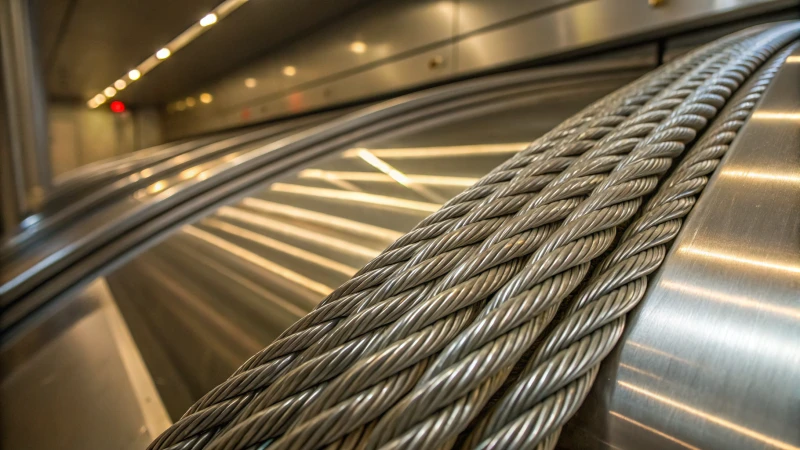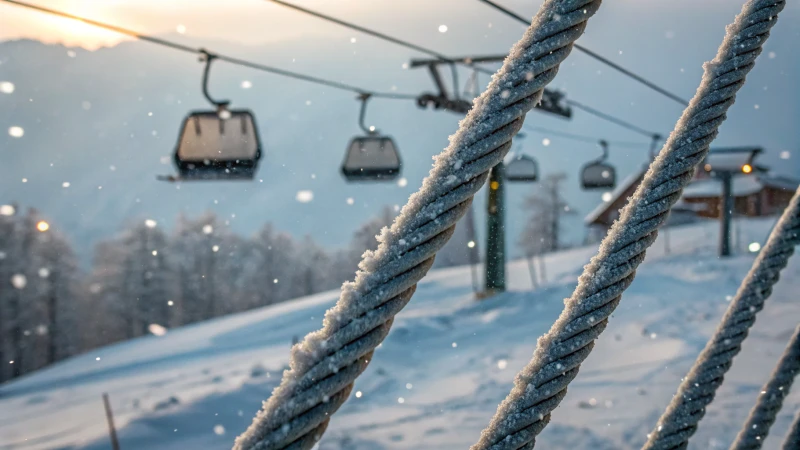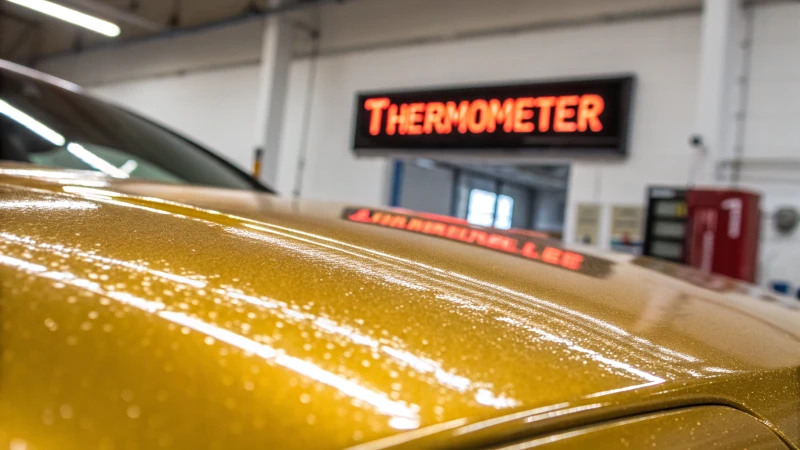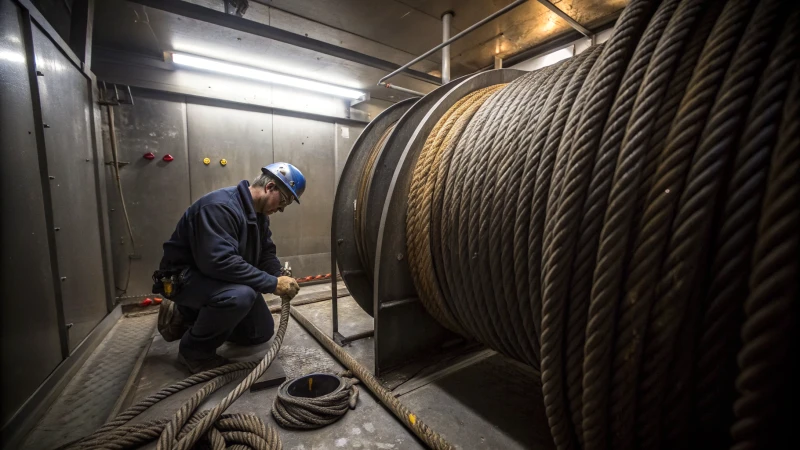
Ever wondered what happens to those steel ropes in elevators when the temperature soars or plummets?
Extreme temperatures can greatly affect steel wire ropes in elevators. When it's too hot, carbon steel ropes might lose their tensile strength, while frigid conditions make them brittle, risking safety. Choosing the right materials and protective coatings can help maintain their performance across varying climates.
I remember a project where we had to deal with the sweltering summer heat in Arizona. It was then I realized that not all steel wire ropes are created equal. High temperatures can really challenge their integrity, especially if you're dealing with carbon steel. I learned that investing in stainless steel or adding protective coatings made a world of difference in maintaining the rope's strength and flexibility.
On the flip side, during a winter stint in Canada, I encountered ropes that became alarmingly brittle. This experience taught me the importance of choosing materials that can withstand such harsh conditions. In this post, I'll explore how you can protect these crucial components from temperature-induced wear and tear, ensuring they remain safe and reliable no matter what Mother Nature throws at them.
High temperatures reduce tensile strength of carbon steel ropes.True
Heat weakens the molecular structure, decreasing tensile strength.
Low temperatures increase the flexibility of steel wire ropes.False
Cold causes brittleness, reducing flexibility and increasing breakage risk.
What happens to steel wire ropes at high temperatures?
Ever wonder how steel wire ropes hold up in the heat of the moment? From construction sites to marine adventures, understanding their resilience is crucial.
High temperatures can reduce the tensile strength of carbon steel wire ropes by up to 20%, while stainless steel options retain most of their strength. Special coatings help mitigate these effects, ensuring safety and reliability.

Effects on Tensile Strength
I remember a summer day on a bustling construction site, where the sun blazed relentlessly, making everything feel like it was melting. It was then that I truly appreciated the importance of choosing the right steel wire ropes for the job. When temperatures soar above 100°C, carbon steel ropes can lose up to 20% of their strength. This is a big deal if you're counting on them to hold heavy loads safely. On the flip side, stainless steel ropes seemed to be the heroes of the day, keeping a solid 95% of their strength intact.
| Material | Retained Strength |
|---|---|
| Carbon Steel | ~80% |
| Stainless Steel | ~95% |
Here's a quick look at how different materials stack up:
Opting for stainless steel can be a game-changer, especially in environments where temperatures flirt with the extreme. I’ve seen firsthand how this choice can lead to fewer headaches and more peace of mind on construction sites1.
The Role of Coatings
Back in my early days working with industrial equipment, I learned about the magic of coatings—silicone or polyurethane—to be precise. These coatings act like a superhero's shield, reducing heat absorption and keeping those steel ropes flexible. A study by ASTM A975 showed polymer-coated ropes performing admirably in temperature extremes, which is why they’ve become a staple in industrial applications2 where temperatures often swing from one extreme to another.
Safety Implications and Recommendations
Ensuring safety isn't just about picking any rope off the shelf—it's about being smart with your choices. Selecting the right type of steel wire rope, and considering additional coatings, are essential steps for preventing accidents and equipment failures due to overheating. I always make sure to conduct regular inspections, checking for any signs of wear or damage. Keeping a log of operational temperatures has also been a lifesaver, helping me forecast maintenance needs and extend equipment lifespan.
Exploring options that offer durability while complying with safety standards3 not only enhances performance but also aligns with industry requirements. It's all about making informed choices that meet both operational demands and ensure everyone gets home safe.
Carbon steel ropes lose 20% strength above 100°C.True
At temperatures above 100°C, carbon steel ropes retain only about 80% of their original strength.
Polymer coatings do not affect steel rope performance.False
Polymer coatings improve performance by reducing heat absorption and maintaining flexibility.
How Does Cold Weather Affect Elevator Wire Ropes?
I remember one chilly winter morning when I learned just how much cold weather can mess with elevator wire ropes, making them more fragile and prone to snapping. It's a lesson I carry with me into every maintenance check.
Cold weather makes elevator wire ropes brittle, decreasing their flexibility and increasing the chance of breakage. Using ropes with special coatings or materials is advised to preserve their integrity in low temperatures.

The Science Behind Cold Weather Effects
I once stood in a freezing elevator shaft, bundled up in layers yet still feeling the icy air biting through. As the temperature dropped below -20°C, I could almost hear the wire ropes stiffening. It's fascinating and a bit scary how the crystalline structure of steel contracts in such cold, reducing its ductility. This makes the ropes more prone to fracture under stress—a real wake-up call for anyone responsible for elevator safety.
Material Considerations
I remember chatting with a colleague who shared how switching from carbon steel to stainless steel ropes made a world of difference in our operations. Stainless steel doesn't lose its strength as much in the cold, unlike carbon steel which can degrade significantly. Coatings like silicone or polyurethane can be lifesavers here—they act like cozy jackets for the wire ropes, helping them stay flexible. Polymer coatings4 are particularly effective.
Safety Implications
I can't stress enough how crucial regular checks are, especially during winter. The reduced flexibility of wire ropes can lead to serious safety concerns. I’ve seen firsthand how a neglected rope can fail, compromising elevator safety, particularly in high-rise buildings. Regular inspections and maintenance are not just routine—they're essential.
Best Practices for Maintenance
When winter rolls around, my maintenance checklist becomes my best friend. Here's a sample I often use:
| Inspection Item | Frequency | Notes |
|---|---|---|
| Visual check for cracks | Weekly | Look for signs of brittleness |
| Tension measurement | Bi-weekly | Ensure consistent tension |
| Coating integrity check | Monthly | Look for wear or peeling |
Technological Advancements
Advancements in metallurgy and material science are a game-changer. New wire ropes designed for extreme temperatures have proprietary alloys and specially designed coatings that enhance performance. I've been reading about research on advanced alloys5 that show promising results—definitely something to consider for future projects.
Incorporating these technologies into procurement strategies can significantly boost safety and efficiency in cold-weather environments. Understanding how wire ropes react to the cold helps me make informed decisions, ensuring the elevators I manage run smoothly year-round.
Cold weather reduces elevator wire rope flexibility.True
Cold temperatures cause the metal's crystalline structure to contract, reducing ductility.
Stainless steel ropes degrade more in cold than carbon steel.False
Stainless steel retains much of its strength in cold, unlike carbon steel.
How effective are polymer coatings for temperature resistance?
Imagine the peace of mind knowing your equipment stands resilient against the harshest temperatures. Could polymer coatings be the key?
Polymer coatings are highly effective at enhancing temperature resistance, serving as a protective barrier that shields materials from thermal damage and prolongs their lifespan.

Understanding Polymer Coatings
Picture this: I once had a project where the machinery was exposed to extreme temperatures, both hot and cold. That's when I discovered the magic of polymer coatings. These coatings act like a superhero cape for surfaces, shielding them from environmental harm. Materials like silicone and polyurethane6 are my go-tos because of their remarkable thermal stability.
How Polymer Coatings Work
Here's how I see it: imagine the coating as a cozy blanket for your equipment. It forms a protective layer that either absorbs or reflects heat. This clever trick reduces heat transfer, ensuring the material beneath stays safe from temperature-induced damage.
Performance Under High Temperatures
In one instance, I needed a solution for equipment that faced scorching conditions. Polymer coatings, like silicone, were perfect as they withstand temperatures up to 300°C. They're ideal for applications in automotive parts and industrial machinery, where the heat is relentless.
| Polymer Type | Temperature Resistance (°C) |
|---|---|
| Silicone | Up to 300 |
| Polyurethane | Up to 200 |
Performance Under Low Temperatures
Think of those bitterly cold mornings when everything feels brittle. In similar conditions, polymer coatings keep materials flexible, preventing brittleness that could lead to disaster. This flexibility is crucial for things like steel wire ropes in cold environments7. I've seen firsthand how polymers help these materials retain their strength and flexibility.
Comparing with Other Coatings
In my experience, polymer coatings often outperform traditional paint or varnish when it comes to temperature resistance. Their molecular structure is like armor against thermal stress, providing superior protection.
Real-world Applications
Industries like aerospace and construction8 heavily rely on polymer coatings for equipment exposed to fluctuating temperatures. By using these coatings, I've seen companies ensure longer-lasting equipment and fewer repairs. Polymer coatings truly are a game-changer in enhancing temperature resistance across various sectors. Their adaptability and effectiveness make them my go-to choice for tackling extreme temperature challenges.
Silicone coatings withstand up to 300°C.True
Silicone coatings are designed to endure high temperatures, up to 300°C.
Polyurethane coatings resist temperatures above 300°C.False
Polyurethane coatings resist temperatures only up to 200°C, not above 300°C.
How Can I Best Maintain Elevator Wire Ropes?
Ever stared up at a towering skyscraper and wondered what keeps those elevators running so smoothly? I have, and it turns out it's all about the cables.
To keep elevator wire ropes in tip-top shape, I make sure to regularly check for wear and corrosion, apply the right lubricants, and maintain proper tension. Following the manufacturer's guidelines is key to preventing failures and extending the ropes' lifespan.

Regular Inspection
I once learned the hard way that routine inspections can save a lot of headaches. Imagine catching a frayed rope just in time! Now, I stick to a schedule that aligns with the manufacturer's recommendations9. Monthly visual inspections, annual comprehensive checks, and biannual safety audits are my go-tos.
| Checkpoints | Frequency |
|---|---|
| Visual Inspection | Monthly |
| Comprehensive Check | Annually |
| Safety Audit | Biannually |
Proper Lubrication
There was this time when a lack of lubrication led to an unfortunate elevator downtime at my building. Since then, I've been diligent about using compatible lubricants to reduce friction. Light mineral oil or synthetic lubricants work best, and I make sure to apply them evenly.
- Recommended Oils: Light mineral oil or synthetic lubricants
- Application Tools: Brush or automatic lubricator
Correct Tensioning
I'll never forget a colleague's story about over-tensioned ropes causing a major scare. To avoid such mishaps, I regularly use a tension gauge to ensure the ropes are just right—not too tight, not too loose.
- Tension Limits: Refer to ISO 4344 standards10
Compliance with Industry Standards
Following standards like ASTM A97511 gives me peace of mind that I'm not cutting corners on safety. Regular audits help me stay on track and spot areas for improvement.
- Key Standards:
- ASTM A975 for elevator ropes
- ISO 4344 for wire rope strength testing
Specialized Coatings for Extreme Conditions
I read about a building in Dubai that tackled extreme temperatures with polymer-coated wires. Inspired by their success, I consider specialized coatings like silicone or polyurethane for challenging environments.
- Case Study: A high-rise building in Dubai successfully reduced rope failures by adopting polymer-coated wires.
Training and Education
Keeping up with the latest in maintenance techniques is crucial. I've found that regular workshops and certifications not only boost my skills but also enhance my confidence in handling new challenges.
Monthly visual inspections are recommended for elevator ropes.True
Routine monthly inspections help detect early signs of wear and tear.
Silicone coatings are unsuitable for extreme conditions.False
Silicone coatings enhance rope performance in extreme temperatures.
Conclusion
Extreme temperatures significantly affect steel wire ropes in elevators, reducing tensile strength and flexibility. Proper material selection and protective coatings are essential for safety and performance.
-
Learn about how high temperatures affect construction machinery performance and what precautions are necessary. ↩
-
Discover the benefits of using polymer-coated steel ropes in various industrial settings. ↩
-
Understand the necessary safety standards for using steel wire ropes in high-temperature environments. ↩
-
Learn about the benefits of polymer coatings in maintaining wire rope flexibility during cold weather. ↩
-
Discover how advanced alloys enhance the performance of wire ropes in extreme temperatures. ↩
-
Discover the specific applications where silicone and polyurethane coatings excel, especially in high-temperature environments. ↩
-
Explore how polymer coatings maintain material flexibility and strength at low temperatures. ↩
-
Learn about the role of polymer coatings in enhancing equipment durability in these industries. ↩
-
Access manufacturer-specific guidelines to ensure you follow the correct maintenance procedures. ↩
-
Understand international standards for tensioning wire ropes to ensure safety and compliance. ↩
-
Familiarize yourself with ASTM standards for maintaining elevator wire ropes effectively. ↩

